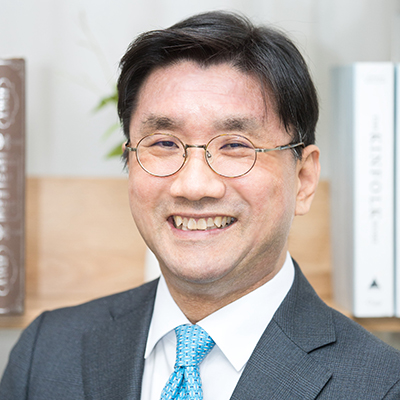Young-Chang Joo, Seoul National University
Candidate for Vice President
 Young-Chang Joo is a professor in the Department of Materials Science and Engineering at Seoul National University in South Korea. He received his BS and MS degrees in Metallurgical Engineering from Seoul National University in 1987 and 1989, respectively. He obtained his PhD in Electronic Materials from the Massachusetts Institute of Technology in 1995. He then joined the Max-Planck Institute for Metals Research in Stuttgart, Germany, in 1995, and continued his career at Advanced Micro Devices, Inc. (AMD) in California, USA, in 1997. He has been a professor in the Department of Materials Science and Engineering at Seoul National University since 1999. From 2020 to 2022, he served as the President of the Advanced Institute of Convergence Technology, an interdisciplinary research institute focused on regional scientific and technological issues, and during the same years, he served as an Outside Director for LG Innotek. Recently, he served as the Vice Minister for Science, Technology, and Innovation at the Korean Ministry of Science and ICT, which is in charge of strategies for science and technology innovation. He mainly worked on deliberating and adjusting budgets for and evaluating the outcomes of national R&D projects.
Young-Chang Joo is a professor in the Department of Materials Science and Engineering at Seoul National University in South Korea. He received his BS and MS degrees in Metallurgical Engineering from Seoul National University in 1987 and 1989, respectively. He obtained his PhD in Electronic Materials from the Massachusetts Institute of Technology in 1995. He then joined the Max-Planck Institute for Metals Research in Stuttgart, Germany, in 1995, and continued his career at Advanced Micro Devices, Inc. (AMD) in California, USA, in 1997. He has been a professor in the Department of Materials Science and Engineering at Seoul National University since 1999. From 2020 to 2022, he served as the President of the Advanced Institute of Convergence Technology, an interdisciplinary research institute focused on regional scientific and technological issues, and during the same years, he served as an Outside Director for LG Innotek. Recently, he served as the Vice Minister for Science, Technology, and Innovation at the Korean Ministry of Science and ICT, which is in charge of strategies for science and technology innovation. He mainly worked on deliberating and adjusting budgets for and evaluating the outcomes of national R&D projects.
Young-Chang Joo has been active in several national and international scientific professional societies. He has served as a general chair, technical chair, and organizer of meetings for several organizations, including MRS, TMS, and IEEE. He has been involved in MRS since his graduate studies, organizing symposiums at the MRS S00, S06, and F03 meetings. He served as a Meeting Chair for the MRS F08. He also served on the MRS Board of Directors from 2016 to 2018. He received the Haedong Award from the Korean Electronic Packaging Society in 2010 and the LS Nikko Award from the Korean Institute of Metals and Materials in 2016. He is also a member of the National Academy of Engineering of Korea.
Young-Chang’s research interests range from the fundamental understanding of mechanical behavior, atomic migration, and the structure of nanomaterials to applicable studies on the reliability and degradation mechanisms of devices and systems, including advanced interconnects and packaging for integrated circuits. His recent research focuses on developing new pathways for the synthesis of materials for energy devices based on nanoscale metallurgy. He is developing electrocatalysts for efficient renewable energy conversion, such as electrochemical carbon dioxide reduction. He has authored over 350 refereed scientific papers and patents.
Candidate's Statement
The MRS stands as the most successful, interdisciplinary, and international society for researchers in the field of materials science and engineering. Over the past 50 years, MRS has shown that transforming from single-discipline to interdisciplinary research has been key in many different areas of science and technology.
I have a profound personal connection to MRS and have been deeply enriched by its success over the years. My first MRS meeting in 1993 was a pivotal moment in my career, introducing me to some of the most talented individuals in the field. Through organizing symposiums, meetings, and serving as a Board member, I have collaborated with members from diverse backgrounds, all working together to shape a vision. It would be a heartfelt honor for me to contribute back to MRS, reciprocating the benefits I have received by actively supporting the ongoing achievements.
My educational and professional journey began in Asia and extended to the United States as well as Europe. Recently, I took a leadership role by serving as the Vice Minister for Science, Technology, and Innovation at the Korean Ministry of Science and ICT, overseeing resource allocation for national R&D. During this tenure, I facilitated cross-sector collaborations. Through countless cooperations and frequent partnerships with the government ministries, agencies, academies, and industries, I was able to expand my perspectives in government R&D policies for better establishing future national agendas on research directions. I believe that these experiences and epiphanies will be of help to MRS in this era with complex geopolitical situations at hand. My diverse background in corporate, academia, and national labs will be invaluable in advancing MRS with a strong emphasis on interdisciplinary research.
As we enter an era defined by rapid technological advancements and significant environmental challenges, the materials science and engineering must evolve to address critical global issues such as carbon emission, AI, cyber security, and healthcare innovations. To tackle these pressing concerns effectively, MRS must not only build on its strengths but also continuously evolve towards achieving innovations.
There is intensifying competition for science and technology leadership. To turn this competition into collaboration and cooperation instead, promoting diversity even further will be an essential building block. With 48% of its members being international, representing 79 different countries, MRS has a strong foundation for diversity and can be a foundation for global communication and collaboration. We should strive to build upon this foundation by expanding diversity and widely accommodating underrepresented groups of different ethnicity, geographical origins and career levels. By holding and co-sponsoring events worldwide and encouraging more international contributions, we can coherently integrate various perspectives and better serve the global materials research community. Additionally, we should engage undergraduates, high school students, policymakers, and others.
Navigating through a technology-driven and post-pandemic era, we must explore new methods of establishing our academic interactions. MRS, as the preeminent society in this field with global visionaries, should actively adopt new technologies that can efficiently engage individuals via both online and offline platforms. To continue to be successful in acting as the “mosaic” in encompassing all generations, and in playing a central role for introducing groundbreaking new findings, MRS should better utilize online platforms and social media. I truly hope MRS can become an avenue for young researchers to create vision and meet lifelong mentors.
It is with great enthusiasm that I seek to contribute my experiences to the dynamic and transformative journey of MRS, ensuring that it remains at the forefront of materials science and engineering and proactively prepares solutions for the world in the age of great transformation.

